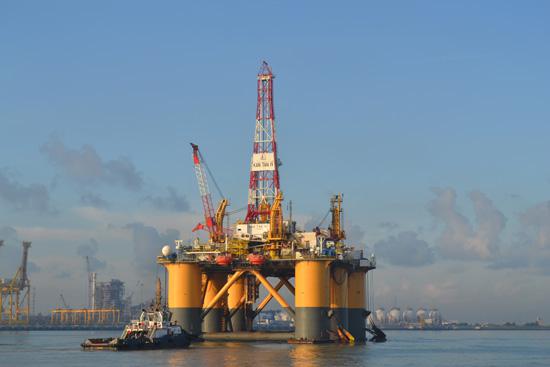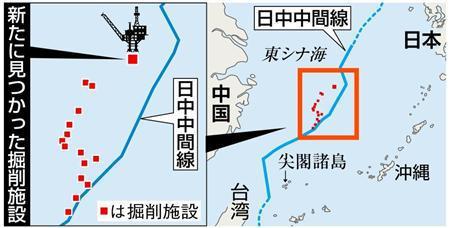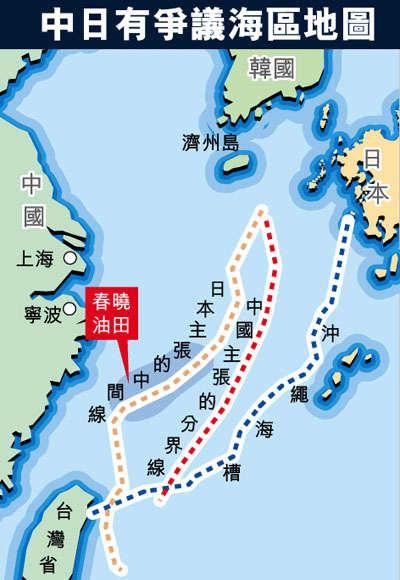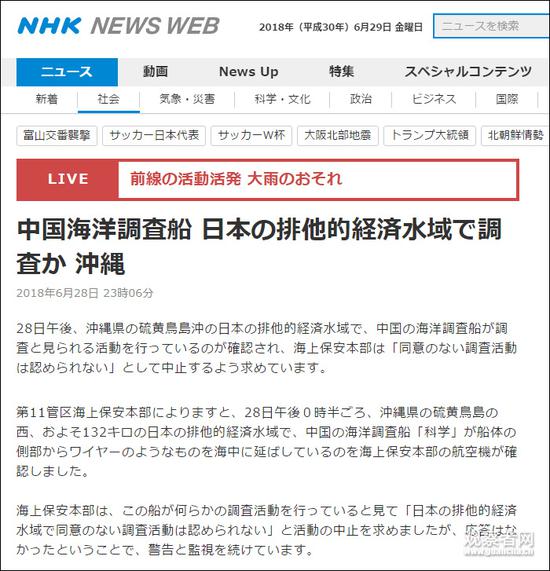http://mil.news.sina.com.cn/china/2018-06-30/doc-ihespqrx2815215.shtml
日称中国开采船现身东海"中日中间线" 或开发新油田
日称中国开采船现身东海"中日中间线" 或开发新油田
0
[观察者网综合报道]据日本产经新闻网29日消息,日本政府近日号称在东海上发现了“新的中国开采船”,随后还以“担心中国单方面进行试验性开采”为由,向中方提出抗议。
对于这个毫无新意的借口,外交部早就表明:中方在中国管辖海域进行开发活动无可非议。
报道称,日本政府相关人士公开表示:确认在“中日中间线”中方一侧内发现了“勘探四号”半潜式钻井平台的身影,但未发现其“作业痕迹”;中方曾将勘探七号自升式钻井平台往这一海域派遣,不过此次勘探四号有别于过去中方常用的“浅海用配置”,而是可以在深海作业的半潜水型钻井船。

勘探四号 图自中石化
日媒因此展开了联想:“介于中方在‘中间线’附近设置了16座天然气油田探钻设施,这次勘探四号的使命很可能是为了单方面开发新的油田。”
对此,该国外相河野太郎于今日(29日)表示,日本对中国单方面开发的举动予以关切,希望中国方面不要“轻举妄动”,还称中方此举“无助于中日友好”。
在无争议的中国管辖海域进行东海油气开发活动,是中国主权权利和管辖权范围内的事情。日方在对此的评论,一口一个“中间线”,显得“振振有辞”;日本经济新闻网甚至还搬出2008年那份“共同开发油田协议”,指责中方的做法“违反合约”。
但这是完全站不住脚的。
首先,关于日本方面单方面声称的东海“中间线”,中方从未接受。外交部早在2013年就表明:中方在中国管辖海域进行开发活动无可非议。

中国从未承认“日中中间线”的合法性
其次,日方政府对中日就“东海问题”在2008年达成的3项共识理解有误。
中日双方当时赞成在不损害各自法律立场的情况下,在东海选择一个区块进行共同开发;此外,日本企业按照中国法律,可参加春晓油气田的合作开发。
需要指出的是,春晓油气田的合作开发和中日商定的共同开发是两回事。中国社会科学院海疆问题专家王晓鹏曾指出,中方过去两年进行海洋作业平台建设的油气田,既不涉及春晓油气田,更不涉及两国先前选择共同开发的龙井油气田。日本政府对中方所谓“违反协议”、“单方面开发”的指责根本是偷换概念,混淆视听。

春晓油田位置示意图
最后,一些日本学者近年来鼓吹所谓“虹吸效应”,称中方在“中间线”中方一侧开采,会“吸走”日方一侧的油气。这也是不科学的。
北京大学国际关系学院日本问题专家梁云祥副教授曾指出,东海大陆架是西高东低,油气作为流体,即使流动,也是从中国这边往日本那边流,不可能倒着流。
自2012年首座深水钻井平台在南海首钻成功后,中国油气勘探重心就转移到了海洋。过程中,我国在东海发现了5至6万亿立方米气当量的油气储量——可供日本用100年。
需要指出的一点是,如果按照日本主张的“中间线”来划分东海油田归属权的话,将有4块油气田落入日本囊中。昨天(28日),中国“科学”号海洋调查船在东海海域进行海洋科考时,就遭到过日本当局的警告和阻挠。

图自NHK新闻网
日方对“中间线”从无到有般的“炒作”,遭到过中方的多次警告。外交部发言人陆康曾指出:日方炒作东海油气问题,显然不利于中日就东海有关问题开展对话与合作。日方的作法是有意制造对立,对管控东海局势、推动两国关系改善不具有任何建设性意义。
关键字 : 中国日本中间线
我要反馈
Japan said that the Chinese mining ship appeared in the East China Sea "China-Japan Middle Line" or developed a new oil field
Japan said that the Chinese mining ship appeared in the East China Sea "China-Japan Middle Line" or developed a new oil field
0
[Observer Network Comprehensive Report] According to the Japanese Sankei News Network on the 29th, the Japanese government recently claimed to have discovered the "new Chinese mining ship" in the East China Sea, and subsequently "fearing China's unilateral experimental mining" as a reason. Protest to the Chinese side.
For this unspoken excuse, the Ministry of Foreign Affairs has long said that it is beyond reproach that China conducts development activities in the waters under Chinese jurisdiction.
According to the report, the Japanese government has publicly stated that it has confirmed that the “Exploration No. 4” semi-submersible drilling rig has been found on the Chinese side of the “China-Japan Middle Line”, but no “work marks” have been found; the Chinese side has explored The No. 7 jack-up rig was dispatched to this area, but this exploration No. 4 is different from the “shallow sea configuration” commonly used by the Chinese in the past, but a semi-submersible drilling ship that can operate in the deep sea.
Exploration No. 4 from Sinopec
Therefore, the Japanese media launched Lenovo: “There are 16 natural gas exploration facilities located near the “middle line” in China. The mission of the No. 4 exploration is likely to be to develop new oil fields unilaterally.”
In response, the foreign minister, Toshiyuki Kotaro, said today (29th) that Japan is concerned about China’s unilateral development and hopes that China will not “be attentive” and that China’s move “will not help China-Japan friendship.”
It is within the scope of China’s sovereign rights and jurisdiction to conduct oil and gas development activities in the East China Sea in the uncontested maritime areas under China’s jurisdiction. Japan's comments on this matter, a "middle line", appears to "resonate"; Japan's economic news network has even moved out of the "co-developed oilfield agreement" in 2008, accusing China of "violation of the contract."
But this is totally untenable.
First of all, China has never accepted the "median line" of the East China Sea that Japan unilaterally claimed. As early as 2013, the Ministry of Foreign Affairs indicated that China’s development activities in the waters under Chinese jurisdiction are beyond reproach.
China has never admitted the legitimacy of the "Japan-China Middle Line"
Second, the Japanese government has misunderstood the three consensuses reached by China and Japan on the “East China Sea issue” in 2008.
At the time, China and Japan agreed to select a block in the East China Sea for joint development without damaging their respective legal positions. In addition, Japanese companies can participate in the cooperative development of Chunxiao oil and gas fields in accordance with Chinese laws.
It should be pointed out that the cooperative development of Chunxiao Oil and Gas Field and the joint development of China and Japan are two different things. Wang Xiaopeng, an expert on sea and land issues at the Chinese Academy of Social Sciences, pointed out that the oil and gas fields constructed by the Chinese side in the past two years have not involved Chunxiao oil and gas fields, nor the Longjing oil and gas fields that the two countries had previously chosen to jointly develop. The Japanese government’s accusation of China’s so-called “violating the agreement” and “unilateral development” is simply to steal the concept and confuse it.
Schematic diagram of Chunxiao Oilfield
Finally, some Japanese scholars have advocated the so-called "siphon effect" in recent years, saying that China will exploit the Chinese side of the "middle line" and will "suck away" oil and gas on the Japanese side. This is also unscientific.
Associate Professor Liang Yunxiang, an expert on Japanese issues at Peking University School of International Relations, pointed out that the East China Sea continental shelf is high in the west and low in the east. Oil and gas as fluids, even if flowing, are also flowing from the Chinese side to the Japanese side, and it is impossible to flow backwards.
Since the first deepwater drilling platform was successfully drilled in South China Sea in 2012, the focus of Chinese oil and gas exploration has shifted to the ocean. During the process, China discovered 5 to 6 trillion cubic meters of gas equivalent of oil and gas reserves in the East China Sea — available to Japan for 100 years.
It should be pointed out that if the ownership of the East China Sea oil field is divided according to the “middle line” advocated by Japan, four oil and gas fields will fall into the Japanese capsule. Yesterday (28th), when the Chinese scientific survey ship "Science" carried out an oceanic examination in the East China Sea, it was warned and obstructed by the Japanese authorities.
Figure from NHK News
The Japanese side has repeatedly warned China of the “hype” that the “middle line” has achieved from nothing. Foreign Ministry spokesman Lu Kang once pointed out that the Japanese side speculation on oil and gas in the East China Sea is obviously not conducive to dialogue and cooperation between China and Japan on relevant issues in the East China Sea. The Japanese side's approach is to intentionally create confrontation, and it does not have any constructive significance in controlling the situation in the East China Sea and promoting the improvement of relations between the two countries.
Keywords : China Japan Middle Line
I want feedback
日称中国开采船现身东海"中日中间线" 或开发新油田
日称中国开采船现身东海"中日中间线" 或开发新油田
0
[观察者网综合报道]据日本产经新闻网29日消息,日本政府近日号称在东海上发现了“新的中国开采船”,随后还以“担心中国单方面进行试验性开采”为由,向中方提出抗议。
对于这个毫无新意的借口,外交部早就表明:中方在中国管辖海域进行开发活动无可非议。
报道称,日本政府相关人士公开表示:确认在“中日中间线”中方一侧内发现了“勘探四号”半潜式钻井平台的身影,但未发现其“作业痕迹”;中方曾将勘探七号自升式钻井平台往这一海域派遣,不过此次勘探四号有别于过去中方常用的“浅海用配置”,而是可以在深海作业的半潜水型钻井船。

勘探四号 图自中石化
日媒因此展开了联想:“介于中方在‘中间线’附近设置了16座天然气油田探钻设施,这次勘探四号的使命很可能是为了单方面开发新的油田。”
对此,该国外相河野太郎于今日(29日)表示,日本对中国单方面开发的举动予以关切,希望中国方面不要“轻举妄动”,还称中方此举“无助于中日友好”。
在无争议的中国管辖海域进行东海油气开发活动,是中国主权权利和管辖权范围内的事情。日方在对此的评论,一口一个“中间线”,显得“振振有辞”;日本经济新闻网甚至还搬出2008年那份“共同开发油田协议”,指责中方的做法“违反合约”。
但这是完全站不住脚的。
首先,关于日本方面单方面声称的东海“中间线”,中方从未接受。外交部早在2013年就表明:中方在中国管辖海域进行开发活动无可非议。

中国从未承认“日中中间线”的合法性
其次,日方政府对中日就“东海问题”在2008年达成的3项共识理解有误。
中日双方当时赞成在不损害各自法律立场的情况下,在东海选择一个区块进行共同开发;此外,日本企业按照中国法律,可参加春晓油气田的合作开发。
需要指出的是,春晓油气田的合作开发和中日商定的共同开发是两回事。中国社会科学院海疆问题专家王晓鹏曾指出,中方过去两年进行海洋作业平台建设的油气田,既不涉及春晓油气田,更不涉及两国先前选择共同开发的龙井油气田。日本政府对中方所谓“违反协议”、“单方面开发”的指责根本是偷换概念,混淆视听。

春晓油田位置示意图
最后,一些日本学者近年来鼓吹所谓“虹吸效应”,称中方在“中间线”中方一侧开采,会“吸走”日方一侧的油气。这也是不科学的。
北京大学国际关系学院日本问题专家梁云祥副教授曾指出,东海大陆架是西高东低,油气作为流体,即使流动,也是从中国这边往日本那边流,不可能倒着流。
自2012年首座深水钻井平台在南海首钻成功后,中国油气勘探重心就转移到了海洋。过程中,我国在东海发现了5至6万亿立方米气当量的油气储量——可供日本用100年。
需要指出的一点是,如果按照日本主张的“中间线”来划分东海油田归属权的话,将有4块油气田落入日本囊中。昨天(28日),中国“科学”号海洋调查船在东海海域进行海洋科考时,就遭到过日本当局的警告和阻挠。

图自NHK新闻网
日方对“中间线”从无到有般的“炒作”,遭到过中方的多次警告。外交部发言人陆康曾指出:日方炒作东海油气问题,显然不利于中日就东海有关问题开展对话与合作。日方的作法是有意制造对立,对管控东海局势、推动两国关系改善不具有任何建设性意义。
关键字 : 中国日本中间线
我要反馈
Japan said that the Chinese mining ship appeared in the East China Sea "China-Japan Middle Line" or developed a new oil field
Japan said that the Chinese mining ship appeared in the East China Sea "China-Japan Middle Line" or developed a new oil field
0
[Observer Network Comprehensive Report] According to the Japanese Sankei News Network on the 29th, the Japanese government recently claimed to have discovered the "new Chinese mining ship" in the East China Sea, and subsequently "fearing China's unilateral experimental mining" as a reason. Protest to the Chinese side.
For this unspoken excuse, the Ministry of Foreign Affairs has long said that it is beyond reproach that China conducts development activities in the waters under Chinese jurisdiction.
According to the report, the Japanese government has publicly stated that it has confirmed that the “Exploration No. 4” semi-submersible drilling rig has been found on the Chinese side of the “China-Japan Middle Line”, but no “work marks” have been found; the Chinese side has explored The No. 7 jack-up rig was dispatched to this area, but this exploration No. 4 is different from the “shallow sea configuration” commonly used by the Chinese in the past, but a semi-submersible drilling ship that can operate in the deep sea.
Exploration No. 4 from Sinopec
Therefore, the Japanese media launched Lenovo: “There are 16 natural gas exploration facilities located near the “middle line” in China. The mission of the No. 4 exploration is likely to be to develop new oil fields unilaterally.”
In response, the foreign minister, Toshiyuki Kotaro, said today (29th) that Japan is concerned about China’s unilateral development and hopes that China will not “be attentive” and that China’s move “will not help China-Japan friendship.”
It is within the scope of China’s sovereign rights and jurisdiction to conduct oil and gas development activities in the East China Sea in the uncontested maritime areas under China’s jurisdiction. Japan's comments on this matter, a "middle line", appears to "resonate"; Japan's economic news network has even moved out of the "co-developed oilfield agreement" in 2008, accusing China of "violation of the contract."
But this is totally untenable.
First of all, China has never accepted the "median line" of the East China Sea that Japan unilaterally claimed. As early as 2013, the Ministry of Foreign Affairs indicated that China’s development activities in the waters under Chinese jurisdiction are beyond reproach.
China has never admitted the legitimacy of the "Japan-China Middle Line"
Second, the Japanese government has misunderstood the three consensuses reached by China and Japan on the “East China Sea issue” in 2008.
At the time, China and Japan agreed to select a block in the East China Sea for joint development without damaging their respective legal positions. In addition, Japanese companies can participate in the cooperative development of Chunxiao oil and gas fields in accordance with Chinese laws.
It should be pointed out that the cooperative development of Chunxiao Oil and Gas Field and the joint development of China and Japan are two different things. Wang Xiaopeng, an expert on sea and land issues at the Chinese Academy of Social Sciences, pointed out that the oil and gas fields constructed by the Chinese side in the past two years have not involved Chunxiao oil and gas fields, nor the Longjing oil and gas fields that the two countries had previously chosen to jointly develop. The Japanese government’s accusation of China’s so-called “violating the agreement” and “unilateral development” is simply to steal the concept and confuse it.
Schematic diagram of Chunxiao Oilfield
Finally, some Japanese scholars have advocated the so-called "siphon effect" in recent years, saying that China will exploit the Chinese side of the "middle line" and will "suck away" oil and gas on the Japanese side. This is also unscientific.
Associate Professor Liang Yunxiang, an expert on Japanese issues at Peking University School of International Relations, pointed out that the East China Sea continental shelf is high in the west and low in the east. Oil and gas as fluids, even if flowing, are also flowing from the Chinese side to the Japanese side, and it is impossible to flow backwards.
Since the first deepwater drilling platform was successfully drilled in South China Sea in 2012, the focus of Chinese oil and gas exploration has shifted to the ocean. During the process, China discovered 5 to 6 trillion cubic meters of gas equivalent of oil and gas reserves in the East China Sea — available to Japan for 100 years.
It should be pointed out that if the ownership of the East China Sea oil field is divided according to the “middle line” advocated by Japan, four oil and gas fields will fall into the Japanese capsule. Yesterday (28th), when the Chinese scientific survey ship "Science" carried out an oceanic examination in the East China Sea, it was warned and obstructed by the Japanese authorities.
Figure from NHK News
The Japanese side has repeatedly warned China of the “hype” that the “middle line” has achieved from nothing. Foreign Ministry spokesman Lu Kang once pointed out that the Japanese side speculation on oil and gas in the East China Sea is obviously not conducive to dialogue and cooperation between China and Japan on relevant issues in the East China Sea. The Japanese side's approach is to intentionally create confrontation, and it does not have any constructive significance in controlling the situation in the East China Sea and promoting the improvement of relations between the two countries.
Keywords : China Japan Middle Line
I want feedback
